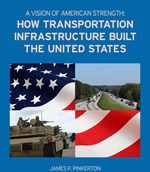 Investing in roads, bridges and other transportation infrastructure has always been and remains the best way to build America’s economic, political, military, strategic and social strength, according to a new book by journalist, thought leader and U.S. domestic policy expert James P. Pinkerton.
Investing in roads, bridges and other transportation infrastructure has always been and remains the best way to build America’s economic, political, military, strategic and social strength, according to a new book by journalist, thought leader and U.S. domestic policy expert James P. Pinkerton.
In “A Vision of American Strength: How Transportation Infrastructure Built the United States,” Pinkerton observes that “the history of civilization is the history of infrastructure.” Societies have flourished as they developed better roads and other transportation systems. Without such infrastructure, it is impossible to create wealth and enhance citizens’ quality of life.
The nation’s leaders understood this concept even before the American Revolution, Pinkerton writes. Young George Washington developed road and canal routes. Later, Alexander Hamilton helped enshrine the power to “regulate commerce” and “establish post offices and post roads” in the U.S. Constitution. That is, the originating document of American governance makes specific reference to the centrality of infrastructure.
Moreover, our third president, Thomas Jefferson, after acquiring the Louisiana Territory and facing up to the challenge of the U.S. becoming a continental power, became a strong supporter of public investment in “roads, canals, rivers, education, and other great foundations of prosperity and union,” culminating in the visionary Gallatin Plan. In a word: infrastructure.
Pinkerton details how this belief fueled the growth of “American Strength” through the 19th and 20th centuries, in both Republican and Democratic administrations: Abraham Lincoln and the Transcontinental Railroad; Theodore Roosevelt and the Panama Canal; Franklin D. Roosevelt and the Works Progress Administration, which built a wide range of infrastructure projects; and Dwight Eisenhower and the Interstate Highway System.
Yet bipartisan support for infrastructure investment began to fracture in the 1970s, Pinkerton writes. On the left, the environmental movement got the better of pro-growth Democrats. On the right, libertarian ideologues convinced Republicans to starve government and turn public works into private projects.
Ironically, it was conservative Ronald Reagan who made the last great defense of infrastructure investment when he supported an increase in the federal gas tax to exclusively finance new transportation improvements. “America can’t afford throwaway roads or disposable transit systems,” Reagan said in a 1982 radio address, reminding the nation that what we fail to repair today will cost many times more tomorrow.
Reagan’s infrastructure revival was short-lived, Pinkerton laments. Federal spending on transportation infrastructure relative to GDP has been cut significantly since the early 1960s. Today, all Americans see the results from years of chronic under-investment: deteriorating roads, bridges and transit systems, and increased traffic congestion.
Pinkerton argues that, “a new and comprehensive infrastructure vision is needed now, more than ever.” This key to economic prosperity and American Strength should not be politically controversial. “There is more common ground between the parties on transportation infrastructure than on most other domestic or foreign issues,” he writes. Boosting investments in transportation infrastructure and developing new “Critical Commerce Corridors” to move goods are potential solutions for rebuilding America.
“A Vision of American Strength: How Transportation Infrastructure Built the United States” is a project of the American Road & Transportation Builders Association’s (ARTBA) Transportation Makes America Work program, which is aimed at building public and political support for increased surface transportation investment.
For more information, go to www.artba.org.

